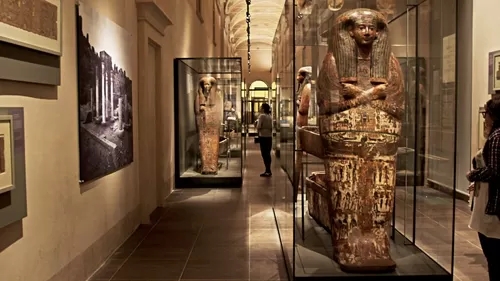Fresh Hope That a Stolen Caravaggio ‘Nativity’ Could Be Found

PALERMO, Sicily — On a stormy night in October 1969, thieves broke into the Oratory of San Lorenzo, a small chapel in what was then Palermo’s dilapidated Kalsa quarter, and made off with one of the city’s artistic masterpieces: Caravaggio’s “Nativity” altarpiece.
Investigators, both national and international, never gave up hunting for the lost painting, which is still No. 2 on the F.B.I.’s list of the top-10 art crimes. Leads pursued in the past all led to dead ends. But new evidence presented at the Oratory this week has revived hopes that the painting might still be found — or, at the very least, that its fate might be discovered.


In the ’60s, no major crime could occur in Palermo without the Mafia knowing about it. So it was natural that investigators looked to Mafia turncoats for clues. Many were interrogated over the years, and some had harrowing tales to tell. One said that the “Nativity” — whose dating flip-flops between 1600 and 1609, depending on which scholars you ask — had been burned in a fire. Another said it had been abandoned and subsequently eaten by mice, or by pigs. Yet another said it had been hidden and was only unveiled during Mafia boss summits. A mobster is said to have used it as a bedside rug.
It was enough to dishearten even the most dogged sleuth.

Then in May last year, yet another turncoat, Gaetano Grado, told his tale to an Italian parliamentary body commonly called the Antimafia Commission. Its president, Rosy Bindi, said in an interview that she had never been convinced by the rumors that swirled around the painting, and so the commission, which has an investigative mandate, decided to dig a little deeper.
Mr. Grado’s story has given investigators fresh hope.
According to this account, two days after the painting was taken, Gaetano Badalamenti, then one of the top Sicilian mobsters, asked Mr. Grado, who at the time was the Mafia member in charge of downtown Palermo, to look into the theft of the Caravaggio. The turncoat said that he tracked down the thieves, and that the painting, after passing through the hands of several mobsters, had eventually ended up with Mr. Badalamenti. (Mr. Badalamenti spent his last 17 years in a federal prison in the United States as one of the leaders of the so-called “pizza connection” drug trafficking ring. He died in 2004.)
Mr. Badalamenti invited a “very old” Swiss art dealer to see the Caravaggio, according to Mr. Grado. When the dealer laid eyes on it, he “sat and cried, and cried,” to the point that Mr. Badalamenti “thought he was stupid,” Mr. Grado recalled. Then the Swiss man announced that he would cut it into pieces because it would not sell otherwise. The dealer, who is not named in the evidence that has been made public, has since died, commission officials said.
Mr. Grado’s account checked out on various fronts. “He’s the first turncoat with a direct connection to the theft,” Francesco Comparone, the commission’s top councilor, said.
On Wednesday, Ms. Bindi said: “If you find the right thread, then everything follows. It’s clear that Grado was that thread.”
Not everyone, however, was convinced.
For the last 10 years, the Oratory where the theft took place has been managed by the Amici dei Musei Siciliani, a cultural association that promotes art in Palermo. On Wednesday, its president, Bernardo Tortorici di Raffadali, told the dignitaries attending the presentation of the Antimafia Commission’s findings, that he thought Mr. Grado’s story didn’t hold up.
He said that over the years, he had moved two altarpieces — including a high-tech digital copy — that had substituted for the missing Caravaggio “a dozen times.” It was “extremely complicated,” he said, because of the size, weight and position of the canvas above the altar.

An operation like this was not something that could be done on the spur of the moment and without a sizable crew, he added. He also pointed out that the thieves had cut the Caravaggio from its wooden frame “without leaving a milligram of paint behind.” It was done with “surgical precision,” Mr. Tortorici said.
“This theft was commissioned,” he said, adding that he didn’t think that line of investigation had been adequately pursued.
Ms. Bindi responded that the commission’s investigation found that the thieves that night “had been under the guidance of two experts in art thefts.” And while the commission found no indication that the Mafia had commissioned the theft, she added, “that doesn’t mean that it didn’t involve people who knew what they were doing.”

Ludovico Gippetto, the president of a Palermo cultural association called Extroart, has also adopted Caravaggio’s “Nativity” for his project “Wanted,” a publicity campaign that involves periodically peppering Palermo with posters of looted artworks on the premise that the better known a work of art is, the harder it is to sell on the black market. In some cases, the strategy has worked, and the works have been anonymously returned. But not in the case of the “Nativity.”
Mr. Gippetto also has doubts about the Mafia’s involvement with the Caravaggio. He said that the daughter of one of the two sisters who were the custodians of the Oratory in 1969 told him that a second object — an item that has not been named in depositions — had also been stolen on the night of the theft, he said. “Why have the police never interrogated her?” he asked.
He’s also been told, “by a source,” that the theft was on commission for “a family so powerful that the police couldn’t even knock on their door,” he said during an interview. He declined to expand further, except to say that the family was not in Italy. “Of course,” he added, “it’s just a hypothesis.”
At least Mr. Grado’s revelations keep the search for the painting alive: The Antimafia Commission’s findings have convinced Palermo prosecutors to open a new investigation into the theft.
Lt. Col. Nicola Candido, the operations commander of the art theft squad in the Caribinieri, Italy’s military police, said that Mr. Grado’s revelations had offered new lines of investigation “involving international police forces,” but none from the United States. He declined to elaborate because investigations were ongoing.
One Caravaggio scholar said she was naturally thrilled that the “Nativity” could still come to light, but was dubious about turncoat accounts. “They haven’t been extraordinarily trustworthy,” Francesca Cappelletti, who teaches at the University of Ferrara, said.
But Ms. Bindi said that the turncoat’s new revelations offered the hope that at least a part of the painting could be recovered. “It would be a way of giving back to the city something that belonged to it,” she said.
Even with a high-quality copy in place, the lost painting leaves a void. In an interview on Wednesday, Leoluca Orlando, Palermo’s mayor, said, “To think that in this moment, this work, or part of this work, could be in someone’s home or a museum — that should upset everyone.”






























 PHOTOGRAPH BY ROBERT HARDING PICTURE LIBRARY, NATIONAL GEOGRAPHIC CREATIVE – The Louvre’s main entrance is illuminated at night. The world’s biggest art museum, the Louvre was robbed in 1911 when museum security was much laxer.
PHOTOGRAPH BY ROBERT HARDING PICTURE LIBRARY, NATIONAL GEOGRAPHIC CREATIVE – The Louvre’s main entrance is illuminated at night. The world’s biggest art museum, the Louvre was robbed in 1911 when museum security was much laxer. PHOTOGRAPH BY PIERRE ADENIS, LAIF/REDUX – Arguably the world’s most famous work of art, the ”Mona Lisa” is now displayed behind thick plexiglass and a wooden barrier to protect it from the 15,000 visitors who flock to the Louvre each day.
PHOTOGRAPH BY PIERRE ADENIS, LAIF/REDUX – Arguably the world’s most famous work of art, the ”Mona Lisa” is now displayed behind thick plexiglass and a wooden barrier to protect it from the 15,000 visitors who flock to the Louvre each day. PHOTOGRAPH BY DAVID GIRAL, ALAMY – The Montreal Museum of Fine Arts was, in 1972, the site of the ”Skylight Caper:” Armed thieves rappelled through a skylight and made off with $2 million worth of paintings and jewelry.
PHOTOGRAPH BY DAVID GIRAL, ALAMY – The Montreal Museum of Fine Arts was, in 1972, the site of the ”Skylight Caper:” Armed thieves rappelled through a skylight and made off with $2 million worth of paintings and jewelry. PHOTOGRAPH BY BETTMANN ARCHIVE, GETTY IMAGES – The MMFA’s then-Director of Public Relations examines photos of the 18 paintings stolen in the 1972 heist. Due to the dramatic method of entry, police suspected the thieves were experienced members of an international crime ring.
PHOTOGRAPH BY BETTMANN ARCHIVE, GETTY IMAGES – The MMFA’s then-Director of Public Relations examines photos of the 18 paintings stolen in the 1972 heist. Due to the dramatic method of entry, police suspected the thieves were experienced members of an international crime ring. PHOTOGRAPH BY KHALED DESOUKI, AFP/GETTY IMAGES – Named for a former Prime Minister of Egypt, the Mohammed Mahmoud Khalil Museum in Cairo, Egypt—notable for its collection of Impressionist and Post-Impressionist works—was robbed in 1978 and 2010.
PHOTOGRAPH BY KHALED DESOUKI, AFP/GETTY IMAGES – Named for a former Prime Minister of Egypt, the Mohammed Mahmoud Khalil Museum in Cairo, Egypt—notable for its collection of Impressionist and Post-Impressionist works—was robbed in 1978 and 2010. PHOTOGRAPH BY ART COLLECTION 2, ALAMY – Post-Impressionist Vincent van Gogh’s ”Poppy Flowers,” also known as ”Vase and Flowers,” was stolen twice from the Mohammed Mahmoud Khalil Museum. Worth at least $50 million, it remains missing.
PHOTOGRAPH BY ART COLLECTION 2, ALAMY – Post-Impressionist Vincent van Gogh’s ”Poppy Flowers,” also known as ”Vase and Flowers,” was stolen twice from the Mohammed Mahmoud Khalil Museum. Worth at least $50 million, it remains missing. PHOTOGRAPH BY DAVID L RYAN, THE BOSTON GLOBE/GETTY IMAGES – Boston’s Isabella Stewart Gardner Museum is known as a “palace turned inside out” because of its beautiful courtyard. In 1990, the Gardner was robbed of 13 paintings worth a collective $500 million, the largest property theft in history.
PHOTOGRAPH BY DAVID L RYAN, THE BOSTON GLOBE/GETTY IMAGES – Boston’s Isabella Stewart Gardner Museum is known as a “palace turned inside out” because of its beautiful courtyard. In 1990, the Gardner was robbed of 13 paintings worth a collective $500 million, the largest property theft in history.  PHOTOGRAPH BY M. SCOTT BRAUER, THE NEW YORK TIMES/REDUX – An empty frame marks the spot where Rembrandt’s “The Storm on the Sea of Galilee” once hung in the Gardner. Vermeer’s “The Concert,” another painting stolen in the 1990 heist, is the world’s most expensive missing work of art, valued at over $200 million.
PHOTOGRAPH BY M. SCOTT BRAUER, THE NEW YORK TIMES/REDUX – An empty frame marks the spot where Rembrandt’s “The Storm on the Sea of Galilee” once hung in the Gardner. Vermeer’s “The Concert,” another painting stolen in the 1990 heist, is the world’s most expensive missing work of art, valued at over $200 million. PHOTOGRAPH COURTESY OF MUSEUM OF ART FAKES – Vienna’s
PHOTOGRAPH COURTESY OF MUSEUM OF ART FAKES – Vienna’s  PHOTOGRAPH BY PAUL FEARN, ALAMY – “The Procuress,” believed to be a forgery by Han van Meegeren, is one of the famous phonies on the walls of the Museum of Art Fakes.
PHOTOGRAPH BY PAUL FEARN, ALAMY – “The Procuress,” believed to be a forgery by Han van Meegeren, is one of the famous phonies on the walls of the Museum of Art Fakes.